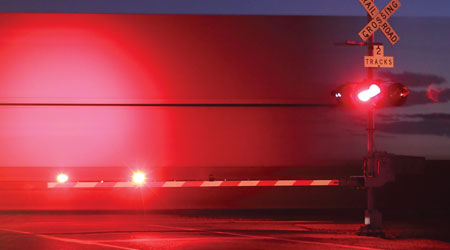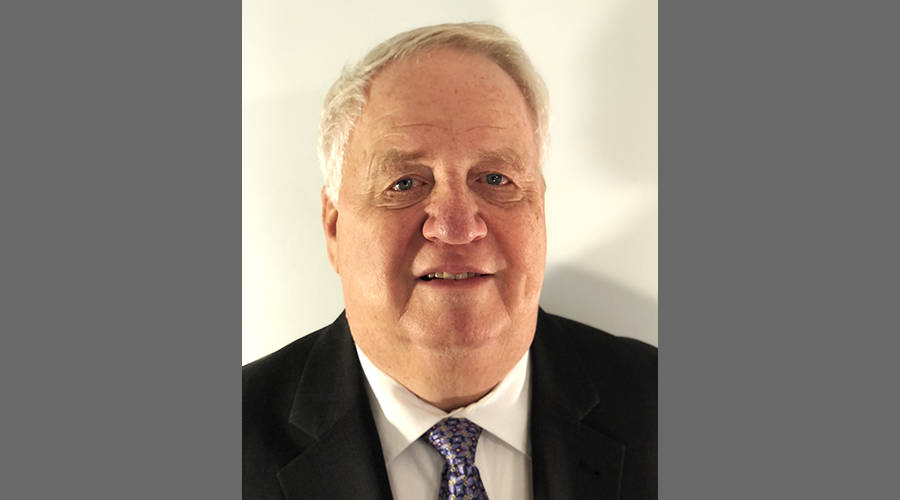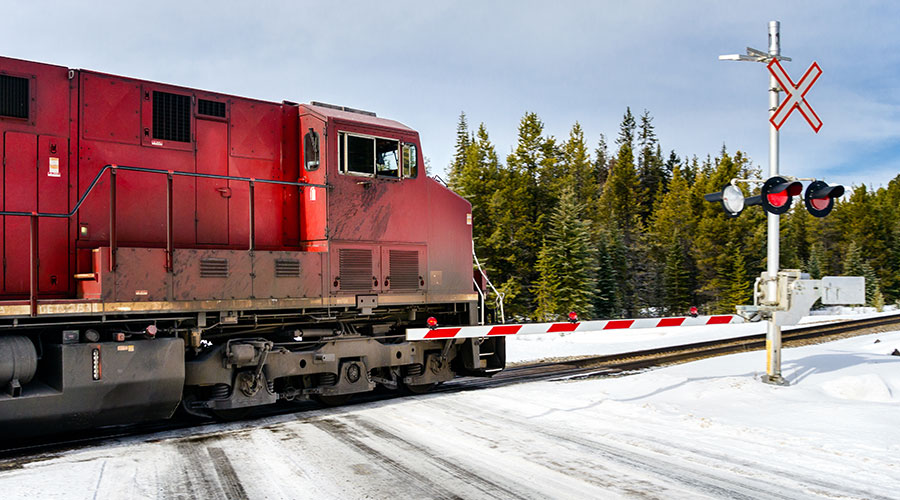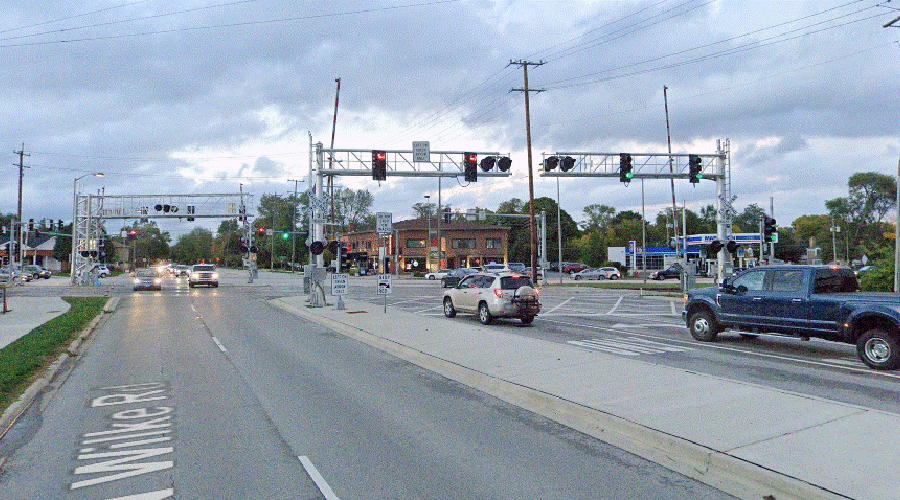Stay updated on news, articles and information for the rail industry
January 2017
Rail News: Safety
Class Is pursue, promote better safety at grade crossings

By Julie Sneider, senior associate editor
Class Is continually search for new ways to improve and promote safety at grade crossings. They also depend on the attention and assistance of others — state and local departments of transportation, law enforcement agencies, Operation Lifesaver chapters and conscientious motorists and pedestrians, for example — to ensure their safety improvements will make a positive difference.
Recently, Progressive Railroading asked Class I representatives to talk about some of their latest efforts to improve crossing safety. Although the number of incidents and fatalities at crossings have declined steadily over the past several years, crossing safety remains a high priority for all U.S. railroads, said Laura Phelps, manager of media relations at CSX.
CSX's crossing safety includes education, public outreach, reduction of redundant crossings, installation and maintenance of signals, resurfacing and vegetation control. The railroad works closely with transportation officials and roadway authorities to participate in diagnostic evaluations at crossings. In many cases, CSX offers financial incentives to communities to offset the costs associated with crossing closures or other safety improvements, Phelps said in an email.
"Once a crossing upgrade project is approved and funded, CSX designs, builds, installs and maintains the warning devices at the crossing," she said.
Also, CSX — like other Class Is — encourages communities to close crossings. When a city or town requests a new highway-rail grade crossing, CSX requires the municipality to identify three comparable active crossings to be closed.
Some states within the CSX network have "progressive policies" that allow them to maximize a source of federal funding for public safety known as Section 130 Railway-Highway Crossings Program, Phelps said. Offered through the Federal Highway Administration, Section 130 funds are allocated to states for installing new active warning devices, upgrading existing devices and improving grade crossing surfaces.
In 2015, CSX partnered with the North Carolina Department of Transportation's (NCDOT) Rail Division to close two crossings in Fremont, N.C. The grade was so steep that large trucks would get caught on the track, creating a potential danger for truck drivers and trains, Phelps said. The NCDOT Rail Division was able to match CSX-supplied private incentive funds, which helped cover the cost to close the crossings.
In 2016, the division evaluated all public crossings along the CSX corridor in Fayetteville, N.C. Division staff identified 20 crossings to be upgraded and nine that are "ideal candidates" for closure, Phelps said.
"Working together with our partners, CSX has successfully executed a program that reaches a variety of audiences and helps to fund safer communities," she said.
Norfolk Southern's pilot project in Missouri
Norfolk Southern Railway also is trying to encourage officials in states along its network to be more aware of using Section 130 and other available funding.
"We are trying to increase our engagement with those states to show them how we can do a corridor project, how we can close a crossing and how we can use those federal monies to close other crossings," said Cayela Wimberly, NS' grade-crossing safety manager.
One state NS has worked with recently is Missouri, where the Class I launched a pilot project to evaluate private crossings and close as many as possible. NS officials analyzed 150 crossings, and were successful in closing 8 percent of those, Wimberly said.
"We negotiated with the landowners and got agreements to create alternate access points and close private crossings," she said.
In 2017, the railroad plans to expand the project to include the states of Georgia, Illinois, Indiana and Florida. On a national scale, there are 10,000 private crossings and 20,000 public crossings in the NS network.
Kansas City Southern, too, "works diligently" with state departments of transportation to implement safety programs, special corridor projects, grant acquisitions and other efforts to improve or upgrade crossings, said KCS spokeswoman Doniele Carlson in an email.
For example, when Louisiana received a $1.1 million grant last year from the Federal Railroad Administration's Safe Transportation of Energy Products (STEP) program to upgrade nine crossings and close six, KCS pledged to contribute 20 percent of the project's total cost. The Class I also will contribute incentive funds to the city of Baton Rouge for the permanent road closures and entirely fund the barricades and removal of roads to be closed, Carlson said.
Last year, KCS worked with states to close six public crossings and with private property owners to close 10 crossings. One project that was particularly important to KCS was in Ashdown, Ark., where KCS — per an agreement with the state — installed flashers and gates at the busy Front Street crossing, Carlson added.
UP takes to social media with safety message
Besides working with states and property owners to close or upgrade crossings, Class Is have created public service announcement campaigns in recent years to promote the crossing-safety message. Last year, Union Pacific Railroad launched a new campaign — titled "Your Life is Worth the Wait" — on social media sites to warn drivers and pedestrians to use caution when approaching crossings and tracks. The campaign also warns people not to take "selfies" or photos of themselves on or around tracks. UP’s message has spread on sites such such as YouTube, Facebook and Twitter.
UP also has distributed the video messages to community organizations, schools and military bases. One message in particular — known as the "duck-face selfie" video — has been broadcast regularly at the San Antonio Spurs' homes games under a partnership with the NBA team, said Buck Russel, UP’s manager of public safety in Texas. That video particularly resonates with teens, he added.
"We're trying to get the public's attention," Russel said. "We are asking people to make better choices."
Keywords
Browse articles on grade crossings safety CSX Norfolk Southern Railway Kansas City Southern Union Pacific Railroad Section 130 North Carolina Department of Transportation Rail Division Federal Railroad Administration Operation Lifesaver duck-face selfie Your Life is Worth the WaitContact Progressive Railroading editorial staff.


 2025 MOW Spending Report: Passenger-rail programs
2025 MOW Spending Report: Passenger-rail programs
 Gardner steps down as Amtrak CEO
Gardner steps down as Amtrak CEO
 Guest comment: Oliver Wyman’s David Hunt
Guest comment: Oliver Wyman’s David Hunt
 Women of Influence in Rail eBook
Women of Influence in Rail eBook
 railPrime
railPrime









